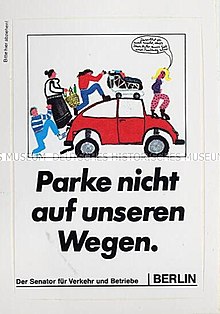Don't park on our paths
Don't park on our paths is a call for traffic discipline . It is directed against disabilities and hazards for road users caused by illegal parking of vehicles on footpaths, cycle paths, pedestrian crossings or similar places. The participants in this movement stick a sticker on these vehicles , which can usually contain not only pictograms but also the text “Do not park on our paths”.
history
The first evidence of the use of stickers with the inscription “Do not park on our paths” has existed at least since 1980, when a letter to the editor and a reproduction of a sticker issued by a Bremen citizens' initiative was printed in the magazine Der Spiegel . In 1986 the magazine mentioned the use of such a sticker in Hamburg in an article . The Senate Department for Transport and Enterprises in Berlin issued its own sticker in 1987. The stickers were later available nationwide in the offices of the ADFC and from associations active in transport policy. The working group of pedestrian and bicycle-friendly cities, municipalities and districts in North Rhine-Westphalia has been promoting the campaign "Don't park on our paths."
In 2015 the Neue Osnabrücker Zeitung reported on activists who put stickers on wrongly parked cars. The Allensbach community had stickers printed and encouraged their use against illegal parking. The ADFC continues to support the movement and is involved in the modernization of funds by simplifying administrative offense reports using a web form or by promoting the Wegeheld app. In December 2017, an action in Stuttgart became known in which incorrectly parked cars were wrapped in cling film . A note on the slide read: "You can park like that, it sucks."
Different adhesive forms
There are three fundamentally different variants of stickers. Self-adhesive, to be moistened (so-called Spuckis or Schleckis) and adhesive. In addition, a distinction has to be made between paper and plastic stickers. Strictly speaking, the adhesive stickers are not stickers, but foils that adhere to the substrate. Such adhesive stickers are always made of plastic and can be removed very easily. Self-adhesive stickers are usually more difficult to remove and therefore lead to property damage more quickly. Stickers to be moistened stick in the same way as classic postage stamps. Self-adhesive paper stickers are the most difficult variant to remove, as they cannot be removed without leaving any residue without problems.
Legal appreciation and affixing
Sticking up someone else's vehicle can be seen as damage to property . The type of fastening can determine whether property damage has occurred. If a sticker is used as a reference, which forms a connection with the paint, so that paint damage occurs when it is removed, property damage is assumed. Letting an adhesive sticker stick will usually not result in damage to property. This is true even if the removal involves considerable effort. In general, it can be said that stickers should not be attached to parts of the vehicle or places that obstruct the view. This means that it cannot be attached to rear-view mirrors, reversing cameras or in the central viewing area of the windshield (the area that is swept over by the windshield wipers). Attachment to the painted surfaces of a vehicle should also be avoided.
Web links
Individual evidence
- ^ Deutsche-digitale-bibliothek.de sticker with a call to traffic discipline.
- ↑ DER SPIEGEL, Volume 34, Issues 19–27, p. 9 Snippet view on Google Books.
- ↑ cf. Claw every day . The Bonn coalition plans to use metal clips to block incorrectly parked cars. In: DER SPIEGEL . No. 4 , January 20, 1986 ( spiegel.de [accessed February 19, 2018]): “The wild parking has already provoked vigilante justice. In Hamburg, disgruntled citizens taped up windscreens with slips of paper ("Don't park on our paths"). In Munich, an "Aktion Pffft" made out of car tires. "
- ↑ Do not park on our paths
- ↑ landtag.nrw.de 56th meeting of the Committee for Building, Housing, Urban Development and Transport (ABWSV). (2015)
- ↑ Neue Osnabrücker Zeitung of February 24th, 2015: STICKER ON THE WINDSHIELD: Reminder notes for parking offenders on Osnabrück cycle paths
- ^ Community of Allensbach: Help against sidewalk parkers - do not park on our paths
- ↑ Harald Wendler: Don't park on our paths: the new Wegeheld app is intended to record traffic offenses. (No longer available online.) In: MG-heute . April 24, 2017, archived from the original on December 10, 2017 ; accessed on February 19, 2018 . Info: The archive link was inserted automatically and has not yet been checked. Please check the original and archive link according to the instructions and then remove this notice.
- ↑ spiegel.de Activists wrap wrong parking cars in foil. (accessed December 19, 2017)
- ↑ gehwege-frei.de legal aspects (accessed on December 10, 2017)
